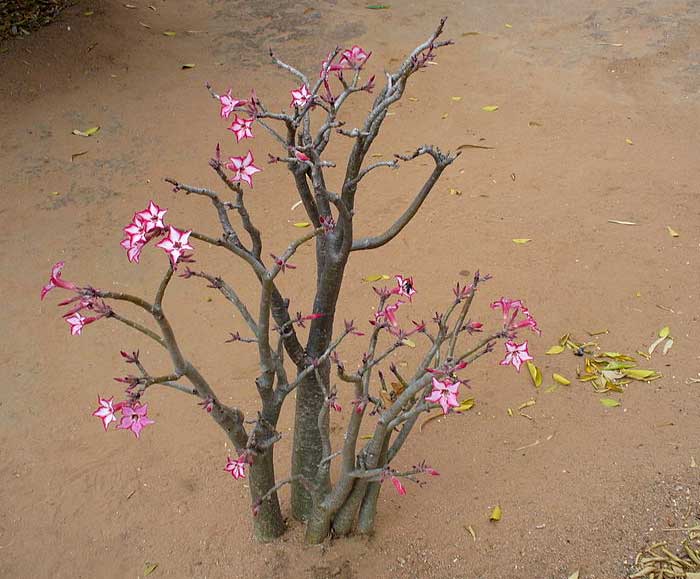
Adenium multiflorum (*)
Classification System: APG IV
Superregnum: Eukaryota
Regnum: Plantae
Cladus: Angiosperms
Cladus: Eudicots
Cladus: Core eudicots
Cladus: Asterids
Cladus: Lamiids
Ordo: Gentianales
Familia: Apocynaceae
Subfamilia: Apocynoideae
Tribus: Nerieae
Subtribus: Neriinae
Genus: Adenium
Species: Adenium multiflorum
Name
Adenium multiflorum Klotzsch (1861).
Synonyms
Homotypic
Adenium obesum subsp. multiflorum (Klotzsch) Rowley, Cact. Succ. J. (Los Angeles) 46: 160. (1974).
Adenium obesum var. multiflorum (Klotzsch) Codd, Bothalia 7: 452. (1961).
Distribution
Native distribution areas:
Continental: Africa
Malawi, Mozambique, Zambia, Zimbabwe, South Africa (Limpopo, Mpulamanga, KwaZulu-Natal), Swaziland
References: Brummitt, R.K. 2001. TDWG – World Geographical Scheme for Recording Plant Distributions, 2nd Edition
References
Klotzsch, J.F. in Peters, W.C.H. 1861. Naturw. Reise Mossambique 6(1): 279, t. 44.
Links
Govaerts, R. et al. 2018. Adenium multiflorum in World Checklist of Selected Plant Families. The Board of Trustees of the Royal Botanic Gardens, Kew. Published on the internet. Accessed: 2018 Sep 25. Reference page.
International Plant Names Index. 2018. Adenium multiflorum. Published online. Accessed: Sep 25 2018.
The Plant List 2013. Adenium multiflorum in The Plant List Version 1.1. Published on the internet. Accessed: 2018 Sep 25.
Tropicos.org 2018. Adenium multiflorum. Missouri Botanical Garden. Published on the internet. Accessed: 2018 Sep 25.
USDA, ARS, Germplasm Resources Information Network. Adenium multiflorum in the Germplasm Resources Information Network (GRIN), U.S. Department of Agriculture Agricultural Research Service. Accessed: 07-Oct-06.
Vernacular names
Afrikaans: Impalalelie
English: Sabi star, Impala lily, Kudu lily
português: Megoza
Adenium multiflorum is small, succulent tree native to central and eastern Southern Africa. It may be deciduous or evergreen, and is found in dry woods or grassland in its native habitat.[1] It is typically 0.5-3 m tall.[2] Like other succulent members of the family Apocynaceae, A. multiflorum has a milky latex with toxic alkaloids, specifically Cardiac glycosides. This latex is used as an arrow poison and as a fish stunning poison.[3]
The leaves are simple, with smooth edges, typically oppositely arranged.[4] The flowers, which appear in winter, are typically 5-petaled and may be red, pink, white, or bi-color.[5] The two-capsuled fruits contain long, grooved, hairy brown seeds.[4]
Sometimes called the impala lily, A. multiflorum requires full sun and excellent drainage. It is extremely drought tolerant, but susceptible to the tobacco whitefly.[6] Though frequently used as a bonsai plant indoors, it may be grown outside in USDA hardiness zones 10 and 11.[7]
It is sometimes treated as a variety or subspecies of Adenium obesum.[2]
References
"Adenium multiflorum – Impala Lily – Buy seeds at rarepalmseeds.com". www.rarepalmseeds.com. Retrieved 2021-03-31.
Stoffel Petrus Bester (June 2004). "Adenium multiflorum Klotzsch". South African National Biodiversity Institute's plant information website.
Neuwinger, Dieter (July 1996). African Ethnobotany: Poisons and Drugs: Chemistry, Pharmacology, Toxicology. Chapman & Hall. p. 941. ISBN 978-3-8261-0077-2.
Becking, David. "Adenium multiflorum | Tree SA". Retrieved 2021-03-31.
"Adenium multiflorum | PlantZAfrica". pza.sanbi.org. Retrieved 2021-03-29.
"Impala Lily (Adenium multiflorum) - Plants | Candide Gardening". Candide. Retrieved 2021-03-31.
"Buy Adenium Multiflorum Seeds - Rarexoticseeds". www.rarexoticseeds.com. Retrieved 2021-03-31.
"Adenium multiflorum". PlantZAfrica.com. Archived from the original on 25 January 2010. Retrieved 2010-02-11.
Retrieved from "http://en.wikipedia.org/"
All text is available under the terms of the GNU Free Documentation License

